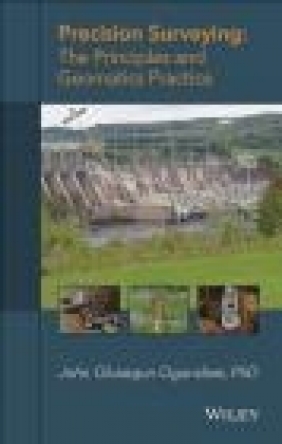Precision Surveying
John Olusegun Ogundare
Precision Surveying
John Olusegun Ogundare
- Producent: John Wiley
- Rok produkcji: 2015
- ISBN: 9781119102519
- Ilość stron: 648
- Oprawa: Twarda
Niedostępna
Opis: Precision Surveying - John Olusegun Ogundare
A comprehensive overview of high precision surveying, including recent developments in geomatics and their applications This book covers advanced precision surveying techniques, their proper use in engineering and geoscience projects, and their importance in the detailed analysis and evaluation of surveying projects. The early chapters review the fundamentals of precision surveying: the types of surveys; survey observations; standards and specifications; and accuracy assessments for angle, distance and position difference measurement systems. The book also covers network design and 3-D coordinating systems before discussing specialized topics such as structural and ground deformation monitoring techniques and analysis, mining surveys, tunneling surveys, and alignment surveys. Precision Surveying: The Principles and Geomatics Practice: * Covers structural and ground deformation monitoring analysis, advanced techniques in mining and tunneling surveys, and high precision alignment of engineering structures * Discusses the standards and specifications available for geomatics projects, including their representations, interpretations, relationships with quality assurance/quality control measures, and their use in geomatics projects * Describes network design and simulation, including error analysis and budgeting * Explains the main properties of high-precision surveys with regard to basic survey procedures and different traditional measurement techniques * Analyzes survey observables such as angle, distance, elevation difference and coordinate difference measurements, and the relevant equipment, including the testing and utilization of the equipment * Provides several case studies and real world examples Precision Surveying: The Principles and Geomatics Practice is written for upper undergraduate students and graduate students in the fields of surveying and geomatics. This textbook is also a resource for geomatics researchers, geomatics software developers, and practicing surveyors and engineers interested in precision surveys.About the Author xvii Foreword xix Preface xxi Acknowledgments xxv 1 Precision Survey Properties and Techniques 1 1.1 Introduction 1 1.2 Basic Classification of Precision Surveys 3 1.3 Precision Geodetic Survey Techniques 8 1.4 Review of Some Safety Issues 12 2 Observables, Measuring Instruments, and Theory of Observation Errors 15 2.1 Observables, Measurements and Measuring Instruments 15 2.2 Angle and Direction Measuring Instruments 16 2.3 Elevation Difference Measuring Instrument 20 2.4 Distance Measuring Instrument 24 2.5 Accuracy Limitations of Modern Survey Instruments 25 2.6 Error Properties of Measurements 28 2.7 Precision and Accuracy Indicators 29 2.8 Systematic Error and Random Error Propagation Laws 30 2.9 Statistical Test of Hypotheses: The Tools for Data Analysis 38 2.10 Need for Equipment Calibration and Testing 44 3 Standards and Specifications for Precision Surveys 47 3.1 Introduction 48 3.2 Standards and the Concept of Confidence Regions 51 3.3 Standards for Traditional Vertical Control Surveys 52 3.4 Standards for Horizontal Control Surveys 66 3.5 Unified Standards for Positional Accuracy 72 3.6 Map and Geospatial Data Accuracy Standards 77 3.7 Quality and Standards 82 4 Accuracy Analysis and Evaluation of Angle Measurement System 87 4.1 Sources of Errors in Angle Measurements 87 4.2 Systematic Errors Eliminated by Measurement Process 88 4.3 Systematic Errors Eliminated by Adjustment Process 98 4.4 Summary of Systematic Error Elimination 106 4.5 Random Error Estimation 106 4.6 Testing Procedure for Precision Theodolites 123 5 Accuracy Analysis and Evaluation of Distance Measurement System 133 5.1 Introduction 133 5.2 General Properties of Waves 134 5.3 Application of EM Waves to EDM 138 5.4 EDM Instrumental Errors 153 5.5 EDM External Errors 154 5.6 Random Error Propagation of EDM Distance Measurement 155 5.7 Calibration and Testing Procedures for EDM Instruments 165 6 Accuracy Analysis and Evaluation of Elevation and Coordinate Difference Measurement Systems 189 6.1 Introduction 189 6.2 Pointing Error 190 6.3 Reading/Rod Plumbing Error 191 6.4 Leveling Error 191 6.5 Collimation, Rod Scale, and Rod Index Errors 192 6.6 Effects of Vertical Atmospheric Refraction and Earth Curvature 193 6.7 Random Error Propagation for Elevation Difference Measurements 194 6.8 Testing Procedures for Leveling Equipment 197 6.9 Calibration of Coordinate Difference Measurement System (GNSS Equipment) 203 7 Survey Design and Analysis 209 7.1 Introduction 209 7.2 Network Design 211 7.3 Solution Approaches to Design Problems 218 7.4 Network Adjustment and Analysis 223 7.5 Angular Measurement Design Example 223 7.6 Distance Measurement Design Example 226 7.7 Traverse Measurement Design Examples 227 7.8 Elevation Difference Measurement Design Example 235 8 Three-Dimensional Coordinating Systems 237 8.1 Introduction 238 8.2 Coordinate System for Three-Dimensional Coordinating Systems 243 8.3 Three-Dimensional Coordination with Global Navigation Satellite System 244 8.4 Three-Dimensional Coordination with Electronic Theodolites 244 8.5 Three-Dimensional Coordination with Laser Systems 258 9 Deformation Monitoring and Analysis: Geodetic Techniques 267 9.1 Introduction 268 9.2 Geodetic Deformation Monitoring Schemes and the Design Approach 273 9.3 Monumentation and Targeting 278 9.4 Horizontal Deformation Monitoring and Analysis 284 9.5 Vertical Deformation Monitoring and Analysis 322 10 Deformation Monitoring and Analysis: High-Definition Survey and Remote Sensing Techniques 329 10.1 Introduction 330 10.2 Laser Systems 330 10.3 Interferometric Synthetic Aperture Radar Technologies 350 10.4 Comparison of Laser (LiDAR) and Radar (InSAR) Technologies 376 11 Deformation Monitoring and Analysis: Geotechnical and Structural Techniques 377 11.1 Introduction 378 11.2 Overview of Geotechnical and Structural Instrumentation 380 11.3 Design of Geotechnical and Structural Monitoring Schemes 419 11.4 Analysis of Geotechnical Measurements 422 11.5 Integrated Deformation Monitoring System 437 12 Mining Surveying 441 12.1 Introduction 442 12.2 Mining Terminology 445 12.3 Horizontal Mine Orientation Surveys 446 12.4 Transferring Levels or Heights Underground 483 12.5 Volume Determination in Mines 491 13 Tunneling Surveys 495 13.1 Introduction 495 13.2 Basic Elements and Methods of Tunneling Surveys 496 13.3 Main Sources of Error in Tunneling Surveys 500 13.4 Horizontal Design and Simulation of Tunneling Surveys 503 13.5 Vertical Design and Simulation of Tunneling Surveys 508 13.6 Numerical Example: Horizontal Breakthrough Analysis 512 13.7 Examples of Tunneling Surveys 516 13.8 Analysis of Underground Traverse Surveys 520 14 Precision Alignment Surveys 527 14.1 Introduction 527 14.2 Direct Laser Alignment Technique 530 14.3 Conventional Surveying Techniques of Alignment 530 14.4 Optical-Tooling Techniques 538 14.5 Metrology by Laser Interferometer Systems 559 14.6 Alignment by Polar Measurement Systems 565 14.7 Main Sources of Error in Alignment Surveys 573 Appendix I: Extracts From Baarda s Nomogram 575 Appendix II: Commonly used Statistical Tables 577 Appendix III: Tau Distribution Table for Significance Level 581 Appendix IV: Important Units 587 References 589 Index 607
Szczegóły: Precision Surveying - John Olusegun Ogundare
Tytuł: Precision Surveying
Autor: John Olusegun Ogundare
Producent: John Wiley
ISBN: 9781119102519
Rok produkcji: 2015
Ilość stron: 648
Oprawa: Twarda
Waga: 1.04 kg






























